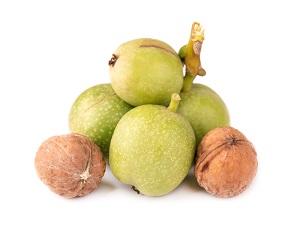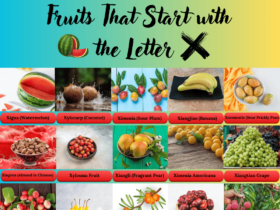Today, let’s explore fruits that start with the letter “C”! There are so many tasty options, from familiar ones like cherries and cranberries to more exotic choices like calamondin and cupuaçu. These fruits come in all kinds of flavors—some are sweet, others are tangy or refreshing. You can enjoy them fresh, and dried, or use them in your favorite dishes and drinks. Whatever you’re in the mood for, there’s definitely a “C” fruit that will fit the bill!
“A quick reminder before trying a new fruit: Some fruits may not be safe to eat raw, and others could be mistaken for inedible or harmful varieties. Do proper research before consuming unfamiliar fruits to ensure safety.”
List of Fruits that Begin with C
1. Cabbage Palm Fruit

2. Cabelluda

3. Cacao Fruit

4. Cachiman

5. Caimito (Star Apple)

6. Calafate Berry

7. Calamansi

8. Calamondin

9. Cambucá
10. Camu Camu

11. Camu-Camu Berry

12. Camu-Camu Plum

13. Canistel

14. Cantaloupe

15. Cantaloupe Melon

16. Cape Gooseberry

17. Caper Berry
18. Capulin Cherry

19. Carambola (Starfruit)

20. Cashew Apple

21. Cattley Guava
22. Cedar Bay Cherry

23. Celeriac Fruit

24. Cempedak

25. Charichuelo
26. Chayote

27. Chayote Squash

28. Cherimoya

29. Cherry

30. Cherry Guava

31. Chilean Guava
32. Chinese Bayberry

33. Chinese Date

34. Chinese Jujube

35. Chocolate Vine Fruit

36. Chokeberry (Aronia)

37. Chontaduro (Peach Palm Fruit)

38. Christmas Melon

39. Clementine

40. Cloudberry

41. Cocona

42. Coconut

43. Coconut Palm Fruit

44. Cocoplum

45. Coffee Cherry

46. Common Fig

47. Crabapple

48. Cranberry

49. Crowberry

50. Cuban Guava

51. Cucumber

52. Cupuacu
53. Currant

54. Custard Apple

55. Ceylon Gooseberry
More Details About Fruits Starting with “C”
| No | Fruit Name | Native Region | Taste | Color | Season | Edible | Culinary Uses |
|---|---|---|---|---|---|---|---|
| 1 | Cabbage Palm Fruit | North America | Slightly Sweet | Orange | Fall | Yes | Jellies, Sauces |
| 2 | Cabelluda | Brazil | Sweet, Juicy | Yellow | Summer | Yes | Jams, Desserts |
| 3 | Cacao Fruit | South America | Sweet, Pulp | Yellow | Year-round | Yes | Chocolate Production |
| 4 | Cachiman | Caribbean | Sweet, Custardy | Green | Summer | Yes | Desserts, Juices |
| 5 | Caimito (Star Apple) | Central America | Sweet, Mild | Purple | Winter | Yes | Snacks, Desserts |
| 6 | Calafate Berry | Chile, Argentina | Sweet, Tart | Blue | Summer | Yes | Jams, Liqueurs |
| 7 | Calamansi | Philippines | Sour, Citrusy | Green/Yellow | Year-round | Yes | Juices, Condiments |
| 8 | Calamondin | China, Philippines | Sour, Tangy | Orange | Year-round | Yes | Marmalades, Juices |
| 9 | Cambucá | Brazil | Sweet, Tart | Yellow | Summer | Yes | Jams, Juices |
| 10 | Camu Camu | Amazon Rainforest | Sour, Tart | Red/Purple | Year-round | Yes | Juices, Supplements |
| 11 | Camu-Camu Berry | Amazon Basin | Sour, Tangy | Red | Year-round | Yes | Juices, Supplements |
| 12 | Camu-Camu Plum | Amazon Rainforest | Sour, Tart | Red | Year-round | Yes | Juices, Liqueurs |
| 13 | Canistel | Central America | Sweet, Custard-like | Yellow | Fall | Yes | Desserts, Smoothies |
| 14 | Cantaloupe | South Asia, Africa | Sweet, Juicy | Orange | Summer | Yes | Snacks, Desserts |
| 15 | Cantaloupe Melon | South Asia, Africa | Sweet, Fragrant | Orange | Summer | Yes | Snacks, Salads |
| 16 | Cape Gooseberry | South America | Sweet, Tart | Yellow | Summer | Yes | Jams, Desserts |
| 17 | Caper Berry | Mediterranean | Salty, Sour | Green | Summer | Yes | Pickles, Garnishes |
| 18 | Capulin Cherry | Mexico, Central America | Sweet, Tart | Red | Spring | Yes | Jams, Juices |
| 19 | Carambola (Starfruit) | Southeast Asia | Sweet, Tart | Yellow | Fall | Yes | Snacks, Juices |
| 20 | Cashew Apple | Brazil | Sweet, Astringent | Yellow/Red | Spring | Yes | Juices, Jellies |
| 21 | Cattley Guava | Brazil | Sweet, Fragrant | Red/Yellow | Summer | Yes | Jams, Desserts |
| 22 | Cedar Bay Cherry | Australia | Sweet, Tart | Red | Summer | Yes | Jams, Desserts |
| 23 | Celeriac Fruit | Europe | Mild, Earthy | White | Fall | Yes | Soups, Salads |
| 24 | Cempedak | Malaysia | Sweet, Fragrant | Yellow | Summer | Yes | Fried, Desserts |
| 25 | Charichuelo | Amazon Rainforest | Sweet, Tangy | Yellow | Summer | Yes | Juices, Desserts |
| 26 | Chayote | Central America | Mild, Crisp | Green | Year-round | Yes | Stir-fries, Salads |
| 27 | Chayote Squash | Central America | Mild, Crisp | Green | Year-round | Yes | Curries, Soups |
| 28 | Cherimoya | Andes, South America | Sweet, Creamy | Green | Winter | Yes | Desserts, Smoothies |
| 29 | Cherry | Europe, Asia | Sweet, Tart | Red | Summer | Yes | Snacks, Pies |
| 30 | Cherry Guava | Brazil | Sweet, Fragrant | Red | Summer | Yes | Jams, Desserts |
| 31 | Chilean Guava | Chile | Sweet, Aromatic | Red | Summer | Yes | Jams, Desserts |
| 32 | Chinese Bayberry | China | Sweet, Tart | Red | Summer | Yes | Juices, Desserts |
| 33 | Chinese Date | China | Sweet, Chewy | Red | Fall | Yes | Snacks, Baking |
| 34 | Chinese Jujube | China | Sweet, Tangy | Red/Brown | Fall | Yes | Snacks, Herbal Teas |
| 35 | Chocolate Vine Fruit | East Asia | Sweet, Mild | Purple | Fall | Yes | Jellies, Snacks |
| 36 | Chokeberry (Aronia) | North America | Tart, Astringent | Black | Fall | Yes | Juices, Syrups |
| 37 | Chontaduro (Peach Palm Fruit) | South America | Sweet, Starchy | Orange | Year-round | Yes | Snacks, Stews |
| 38 | Christmas Melon | Spain | Sweet, Juicy | Yellow/Green | Summer | Yes | Snacks, Desserts |
| 39 | Clementine | North Africa | Sweet, Juicy | Orange | Winter | Yes | Snacks, Juices |
| 40 | Cloudberry | Northern Hemisphere | Sweet, Tart | Orange | Summer | Yes | Jams, Desserts |
| 41 | Cocona | Amazon Rainforest | Sour, Tangy | Yellow | Year-round | Yes | Juices, Sauces |
| 42 | Coconut | Tropical Regions | Mild, Nutty | Brown | Year-round | Yes | Snacks, Milk |
| 43 | Coconut Palm Fruit | Tropical Regions | Mild, Sweet | Brown | Year-round | Yes | Snacks, Oil |
| 44 | Cocoplum | Caribbean | Sweet, Tart | Red | Fall | Yes | Jams, Sauces |
| 45 | Coffee Cherry | Africa | Sweet, Mild | Red | Year-round | Yes | Extracts, Drinks |
| 46 | Common Fig | Mediterranean | Sweet, Juicy | Purple | Summer | Yes | Snacks, Baking |
| 47 | Crabapple | Europe, Asia | Sour, Tart | Red | Fall | Yes | Jellies, Sauces |
| 48 | Cranberry | North America | Tart | Red | Fall | Yes | Jellies, Sauces |
| 49 | Crowberry | Northern Hemisphere | Tart | Black | Summer | Yes | Jams, Liqueurs |
| 50 | Cuban Guava | Cuba | Sweet, Fragrant | Yellow | Summer | Yes | Jams, Desserts |
| 51 | Cucumber | South Asia | Mild, Crisp | Green | Summer | Yes | Salads, Pickles |
| 52 | Cupuacu | Amazon Basin | Sweet, Tangy | Brown | Year-round | Yes | Desserts, Chocolates |
| 53 | Currant | Europe | Tart, Sweet | Red/Black | Summer | Yes | Jams, Sauces |
| 54 | Custard Apple | India, Southeast Asia | Sweet, Creamy | Green | Fall | Yes | Desserts, Smoothies |
| 55 | Ceylon Gooseberry | Sri Lanka | Tart, Sweet | Red | Summer | Yes | Jams, Desserts |
FAQs:
What fruit starts with the letter C?
Cocoplum, Cranberry, Custard Apple, Coconut, Cacao Fruit, Cherry, & Cumber are some example of fruits that start with C.
What dried fruit starts with C?
A dried fruit that starts with the letter “C” is cranberry.
What is a purple fruit that starts with C?
A purple fruit that starts with the letter “C” is Chocolate Vine Fruit.
Is Cucumber a fruit or vegetable?
Cucumber is technically considered a fruit because it develops from the flower of the cucumber plant and contains seeds.







Leave a Reply